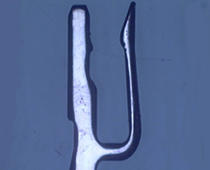Tin is widely used for joining connectors, crimp-type terminals, and various other electronic parts as solder plating because its melting point is as low as 232°C and its solderability is excellent. Conventionally, Sn-10%Pb solder plating, melting at a low point of 183°C, would play an active part, but because lead-containing solder plating has become unusable according to an RoHS Directive, reflow tin plating, Sn-Cu alloy plating, Sn-Bi alloy plating, and Sn-Ag alloy plating are playing more active parts as lead-free solder plating at present.
| Type of plating | Features | Characteristic value |
|---|---|---|
| Alkaline bath (potassium stannate bath) |
Suitable for complex-shaped parts, such as crimp-type terminals because the flexibility of plating films is high and the uniform electrodeposition of plating is excellent. | Hv 3~4 |
| Methanesulfonic acid bath (alkanolsulfonic acid bath) |
- Good for hoop plating (connectors, lead frames, and other electronic parts) because plating can be performed with a high current density. - Reflow tin plating is suitable for connectors. Reflow treatment is to reliably remove compressive residual stress, which is the most common cause of whisker occurrence, by heating and melting tin at above its melting point after plating. |
Dull(Hv5~8) - Semigloss, bright tin (Hv40 – 60) plating |
| Sulfuric acid bath | Good for rack and barrel plating. | |
| Neutral bath (carboxylic acid bath) | Suitable for acid- and alkali-sensitive materials; used for chip resistors and chip capacitors. | Hv10~15 |

Reflow tin plating